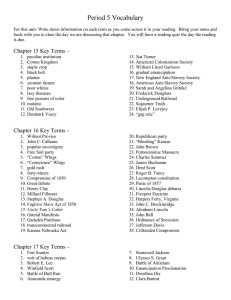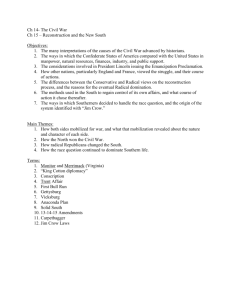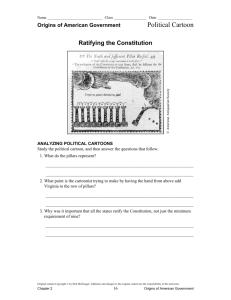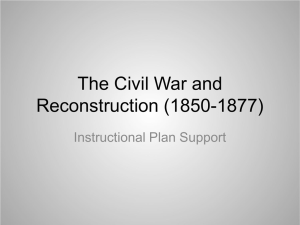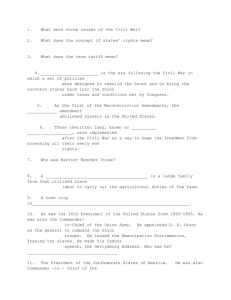AP US History * Unit Four
advertisement
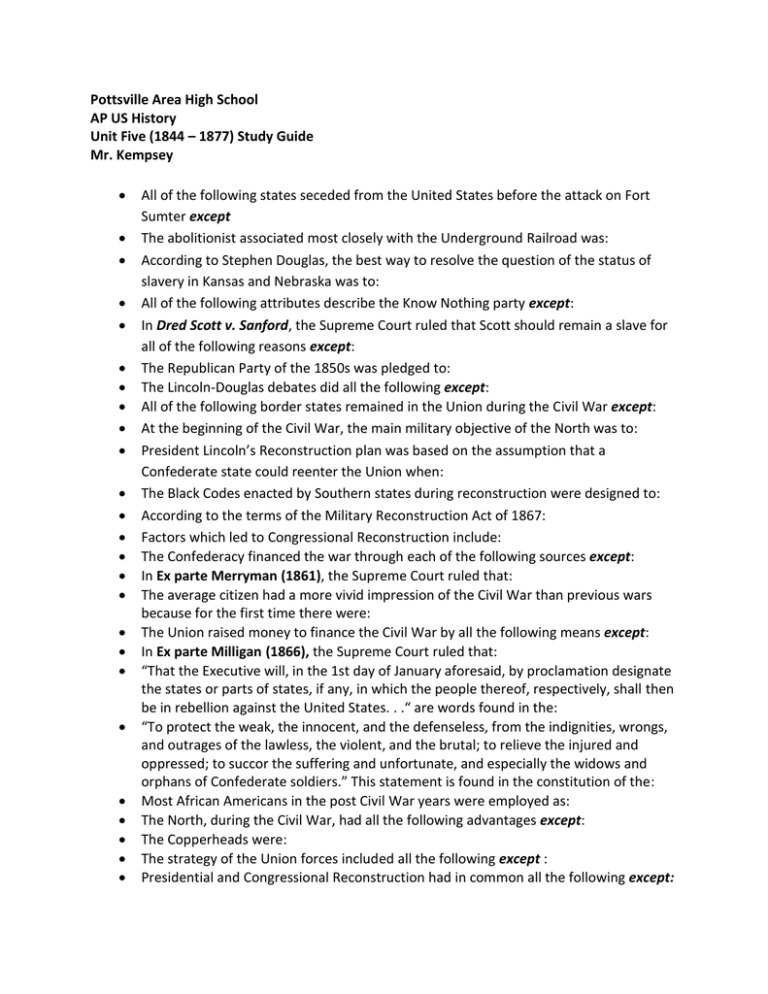
Pottsville Area High School AP US History Unit Five (1844 – 1877) Study Guide Mr. Kempsey All of the following states seceded from the United States before the attack on Fort Sumter except The abolitionist associated most closely with the Underground Railroad was: According to Stephen Douglas, the best way to resolve the question of the status of slavery in Kansas and Nebraska was to: All of the following attributes describe the Know Nothing party except: In Dred Scott v. Sanford, the Supreme Court ruled that Scott should remain a slave for all of the following reasons except: The Republican Party of the 1850s was pledged to: The Lincoln-Douglas debates did all the following except: All of the following border states remained in the Union during the Civil War except: At the beginning of the Civil War, the main military objective of the North was to: President Lincoln’s Reconstruction plan was based on the assumption that a Confederate state could reenter the Union when: The Black Codes enacted by Southern states during reconstruction were designed to: According to the terms of the Military Reconstruction Act of 1867: Factors which led to Congressional Reconstruction include: The Confederacy financed the war through each of the following sources except: In Ex parte Merryman (1861), the Supreme Court ruled that: The average citizen had a more vivid impression of the Civil War than previous wars because for the first time there were: The Union raised money to finance the Civil War by all the following means except: In Ex parte Milligan (1866), the Supreme Court ruled that: “That the Executive will, in the 1st day of January aforesaid, by proclamation designate the states or parts of states, if any, in which the people thereof, respectively, shall then be in rebellion against the United States. . .“ are words found in the: “To protect the weak, the innocent, and the defenseless, from the indignities, wrongs, and outrages of the lawless, the violent, and the brutal; to relieve the injured and oppressed; to succor the suffering and unfortunate, and especially the widows and orphans of Confederate soldiers.” This statement is found in the constitution of the: Most African Americans in the post Civil War years were employed as: The North, during the Civil War, had all the following advantages except: The Copperheads were: The strategy of the Union forces included all the following except : Presidential and Congressional Reconstruction had in common all the following except: The North and the South began to split in the middle of the 19th century over: The South after Reconstruction: The Republican Party platform in 1860 stood for: Two major turning point battles of the Civil War were: Scalawags were: All the following states reported disputed returns in the 1876 election except: The rapid industrialization of the North after the Civil War was due to: In 1865, the Union troops made their final push against Richmond by capturing: “I have no purpose, directly or indirectly, to interfere with the institution of slavery in the States where it exists. I believe I have no lawful right to do so, and I have no inclination to do so.” These words were spoken in 1861 by: The statements in the Emancipation Proclamation were designed to do all the following except: Many of the working class people in the North were not enthusiastic about freeing the slaves because they would: In 1867, Congress became the most powerful branch of government by doing all the following except: All of the following were advantages held by the Confederacy at the beginning of the Civil War except: “. . . feeling that valour and devotion could accomplish nothing that could compensate for the loss that would have attended the continuation of the contest, I have determined to avoid the useless sacrifice of those whose past services have endeared them to their countrymen.” These farewell words were spoken by All of the following acts were passed by Congress during the Civil War except the: FRANCHISE - a constitutional or statutory right or privilege; especially: the right to vote Which of the following groups would be most likely to support the perspective of the cartoon? The sentiments expressed in the cartoon above most directly contributed to which of the following? The controversy highlighted in the cartoon above most directly led to the The ideas expressed in the cartoon above most directly reflect which of the following continuities in United States history? Which of the following 20th-century issues most closely parallels the controversy depicted in the cartoon above? (1) Widespread support for this cartoonist’s viewpoint about Reconstruction most directly led to… Which of the following gradually weakened the “strong government” pictured in the cartoon in the years leading up to the 1876 election? Which of the following groups would most clearly have supported this cartoonist’s opinion on Reconstruction? “We claim exactly the same rights, privileges, and immunities as are enjoyed by white men-we ask nothing more and will be content with e entitled to ride in nothing less… The law no longer knows white nor black, but simply men, and consequently we are entitled to ride in public conveyances, hold office, sit on juries, and do everything else which we have in the past been prevented from doing solely on the ground of color.” -Report of the Colored Convention in Alabama (1865) (3) The demands of the passage above were most clearly granted by the… Which of the following groups would most strongly have supported the position described in this passage? Which of the following best describes the results of Reconstruction efforts toward the goals expressed in the passage? The calls for equality in the passage above most directly built upon “When Daniel Webster declared, after the passage of the Compromise of 1850, that the Union stood firm, the great orator was engaging in exhortation rather than description. The California compromise, far from soothing sectional passions, inflamed them. Many northerners were incensed by the opening of Utah and New Mexico to slavery, and were even more outraged by the Fugitive Slave Act… In pounding on the Union’s door in 1850, California awakened the dogs of division and set them howling all at once. From the Compromise of 1850 ran a straight, if tortured, path to southern secession and Civil War.” -H.W. Brands, The Age of Gold (2002) (3) Which of the following developments most strongly supports Brands’s argument? The inflammation of “sectional passions” referenced in the passage had been sparked by which of the following? On what basis had the Compromise of 1850 hoped to restore national unity? Which of the following had most strongly contributed to the sectionalism that Brands argues was made worse by the Compromise of 1850? “Neither slavery nor involuntary servitude, except as a punishment for crime whereof the party shall have been duly convicted, shall exist within the United States.” Thirteenth Amendment to the U.S. Constitution (1865) “All persons born or naturalized in the United States, and subject to the jurisdiction thereof, are citizens of the United States and of the State wherein they reside.” Fourteenth Amendment to the U.S. Constitution (1868) “The right of citizens of the United States to vote shall not be denied or abridged by the United States or by any State on account of race, color, or previous condition of servitude.” Fifteenth Amendment to the U.S. Constitution (1870) (4) The intent of these amendments was most directly undermined by Which of the following groups most actively opposed the efforts of these amendments? Which of the following best explains the ideology behind the three amendments listed here? During which of the following periods was the most progress made in protecting the rights promised by these three amendments?

